#canadian destroyer
Explore tagged Tumblr posts
Text

25 notes
·
View notes
Text

Abstract interpretation of the song Harem of Scorpions by Cancer Bats. Personally very proud of this one 💥🖤
2 notes
·
View notes
Text
chuck is just there cheering his friends on ringside and john silver had to give him the ol' boot to the face for it. evil. dark, even
#livezon#trent's strong zero being turned into a (? canadian destroyer) by uno's kick was cool#jericho on commentary... -_-
2 notes
·
View notes
Text
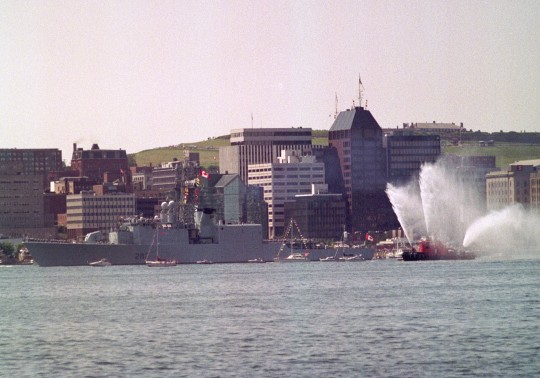
HMCS Athabaskan, Halifax, 1990
#HMCS Athabaskan#Halifax#1990#RCN#Royal Canadian Navy#Destroyer#Iroquois Class#naval#nautical#photography#hide and queue
11 notes
·
View notes
Text
ospreay vs yoshi-hashi match of the night argue with a wall
#yoshi-hashi canadian destroyer... ospreay fully bleeding from the mouth... gasped out loud multiple times#g1 lb
5 notes
·
View notes
Text
GUYS COME ONNNNN DUSTIN RHODES IS SO FUN
6 notes
·
View notes
Text
Full Kudos to Crazzy Steve and Trey Miguel for that Monsters Ball. Genuinely so much fun, a massacre in a beautiful way
#They went that hard. they didn’t have to#So many tacks#and the barbed wire#JANICE!#and that Canadian Destroyer? Oh my gosh#Crazzy Steve#Trey Miguel#Impact Wrestling
1 note
·
View note
Text
andre chase might be one of thee characters of all time
#im macklemore and youre watching disney channel#watching no mercy#dude wears sweaters and slacks to wrestle and has an insanely deep bag#pulls out canadian destroyers on a random tuesday#he also has a major gambling problem and is the dean of a university#gets beat up by his students every once in a while
0 notes
Text
🏳️🌈
Place: HMCS Haida
📍 Hamilton,ON
June/ 2024
#tumblr#canada#canadian#lunaluks#HMCS Haida#ship#war ship#Tribal-class destroyer#lgbt#lgbtq#lgbtqia#summer#2024
0 notes
Text
#Elder Caius#Super Destroyer#progressive metal#progressive rock#prog metal#prog rock#metal#heavy metal#rock#prog#St. John’s#Newfoundland#Newfoundland and Labrador#NL#NFLD#Heavy NFLD#YYT#709#Canada#Canadian rock#Canadian metal#Canadian prog#Newfoundland rock#Newfoundland metal#Newfoundland prog
0 notes
Text
i am the most predictable son of a bitch. i stumble across a clip of roman reigns pinned to the floor, one of his arm in a handcuff, dolph ziggler sitting on top, trying to forcefeed him dog food and my enjoyment of him suddenly rise 300%. of course i would be super into him after seeing that OF FUCKING COURSE.
#okay the usos did save him from the dog food punishment so he's not as humiliated#but anyway#i guess what draws me in is that a guy like him#all big imposing and strong#reduced to laying down vulnerable on the floor#and when he fights he get punched on the head and we get to see him#act like it really hurts. like it made him and he went limp for a sec#and then when dolph took that few secs chance to handcuff him#he did his job of stirring a bit and then jump from 0 to 100 in panic because he's tied up now#yeah.... that is what i really like about wrestling#idc if they can do canadian destroyers or moonsaults#what matters other than basic wrestling ability is they can sell and they can be funny#i dont want a silent badass i want a guy who lets his struggle and pain visible in a fight#so his wins meant something#and the losses of his opponents are dignified#and i also want people who dont take themselves too seriously#who dont mind losing or making a fool of themselves#just as long as the end results of the shows look entertaining#wrasslin
0 notes
Text
also I may be alone in this but I think the anti-canadiandestroyer sign is based. that move sucks.
#first few times I saw a Canadian destroyer i couldnt figure out who was giving it and who was receiving it#its just not a good looking move and v few ppl can even pull it off decently
1 note
·
View note
Text

"Halifax" the cat came aboard while one of the US destroyers (now transferred to the Royal Navy) was in a Canadian port. Halifax was the ship's mascot and wore an HMS cap ribbon round his neck. Oct. 1940
119 notes
·
View notes
Text
"Hey, buddy, you've been hogging the Supercharger® long enough," emits the carrier signal of a Tesla owner. They're right to be upset. Ever since they opened up their fancy DC fast chargers to every Tom, Dick, and Ford owner, what was once a hoity-toity elite parking lot full of American-made economy cars is now full of a bunch of weird shitbags trying to fill up their batteries.
My electric car? Pretty much the same as yours: a 1974 Plymouth Fury III, with the original smog-coughing low-compression 400-cubic-inch V8 engine replaced with nearly a metric ton of golf-cart batteries I borrowed from the local country club. Hey, they weren't using any of them in the middle of November when I cut through the fence. Not to mention it's unethical for anyone to hoard valuable resources that could be used to reduce emissions, such as I am doing (unless you count the fact that this vehicle is still, somehow, leaking 10w40 motor oil from somewhere.)
The system isn't perfect. For instance, the "fast charge" system is not particularly fast. This is because it's an old Canadian Tire 12-volt boat battery maintainer that I've riveted onto the hood, and tricked the Tesla system into talking to. As far as the computer inside it knows, it's just a really stupid SUV. Before you blame me for being a charge hog, you must also know this: it is keeping my decrepit Galaxy Note smartphone alive, which hasn't had a working battery in it since that whole airplane fire snafu. And in turn, that phone is playing an educational podcast, about climate destroyers. This, I believe, is what the Tesla owner is actually angry about, and not the fact that I have been "fast charging" for the last seventeen hours using a stolen credit card.
I ignore him. I have long ago learned that pedestrians talk a lot of shit, but are generally afraid to actually damage my car: an emergency tetanus shot, after all, is unpleasant and can cost upwards of $25. Walking back inside the donut store at which I am "parked," I ask the attendant to refill my bottomless coffee once more. Maybe I'll live here, I think. I don't want to go anywhere more than about five miles away from this charger from now on.
920 notes
·
View notes
Text
D-Day was 80 years ago today!
D-Day was the first day of Operation Overlord, the Allied attack on German-occupied Western Europe, which began on the beaches of Normandy, France, on 6 June 1944. Primarily US, British, and Canadian troops, with naval and air support, attacked five beaches, landing some 135,000 men in a day widely considered to have changed history.
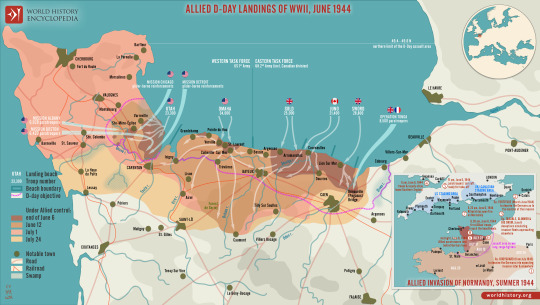
Where to Attack?
Operation Overlord, which sought to attack occupied Europe starting with an amphibious landing in northwest France, Belgium, or the Netherlands, had been in the planning since January 1943 when Allied leaders agreed to the build-up of British and US troops in Britain. The Allies were unsure where exactly to land, but the requirements were simple: as short a sea crossing as possible and within range of Allied fighter cover. A third requirement was to have a major port nearby, which could be captured and used to land further troops and equipment. The best fit seemed to be Normandy with its flat beaches and port of Cherbourg.
The Atlantic Wall
The leader of Nazi Germany, Adolf Hitler (1889-1945), called his western line of defences the Atlantic Wall. It had gaps but presented an impressive string of fortifications along the coast from Spain to the Netherlands. Construction of gun batteries, bunker networks, and observation posts began as early as 1942.
Many of the German divisions were not crack troops but inexperienced soldiers, who were spending more time building defences than in vital military training. There was a woeful lack of materials for Hitler's dream of the Atlantic Wall, really something of a Swiss cheese, with some strong areas, but many holes. The German army was not provided with sufficient mines, explosives, concrete, or labourers to better protect the coastline. At least one-third of gun positions still had no casement protection. Many installations were not bomb-proof. Another serious weakness was naval and air support. The navy had a mere 4 destroyers available and 39 E-boats while the Luftwaffe's (German Air Force's) contribution was equally paltry with only 319 planes operating in the skies when the invasion took place (rising to 1,000) in the second week.
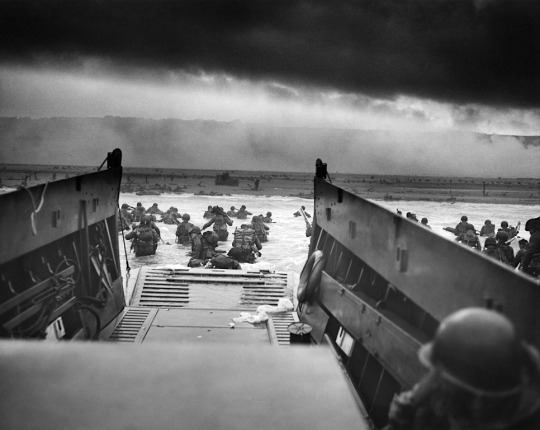
Neptune to Normandy
Preparation for Overlord occurred right through April and May of 1940 when the Royal Air Force (RAF) and United States Air Force (USAAF) relentlessly bombed communications and transportation systems in France as well as coastal defences, airfields, industrial targets, and military installations. In total, over 200,000 missions were conducted to weaken as much as possible the Nazi defences ready for the infantry troops about to be involved in the largest troop movement in history. The French Resistance also played their part in preparing the way by blowing up train lines and communication systems that would ensure the defenders could not effectively respond to the invasion.
The Allied fleet of 7,000 vessels of all kinds departed from English south-coast ports such as Falmouth, Plymouth, Poole, Portsmouth, Newhaven, and Harwich. In an operation code-named Neptune, the ships gathered off Portsmouth in a zone called 'Piccadilly Circus' after the busy London road junction, and then made their way to Normandy and the assault areas. At the same time, gliders and planes flew to the Cherbourg peninsula in the west and Ouistreham on the eastern edge of the planned landing. Paratroopers of the 82nd and 101st US Airborne Division attacked in the west to try and cut off Cherbourg. At the eastern extremity of the operation, paratroopers of the 6th British Airborne Division aimed to secure Pegasus Bridge over the Caen Canal. Other tasks of the paratrooper and glider units were to destroy bridges to impede the enemy, hold others necessary for the invasion to progress, destroy gun emplacements, secure the beach exits, and protect the invasion's flanks.
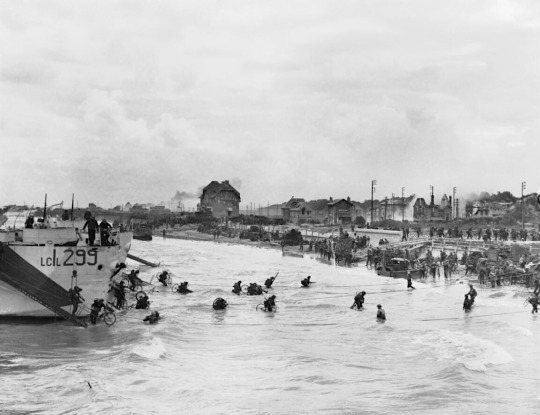
The Beaches
The amphibious attack was set for dawn on 5 June, daylight being a requirement for the necessary air and naval support. Bad weather led to a postponement of 24 hours. Shortly after midnight, the first waves of 23,000 British and American paratroopers landed in France. US paratroopers who dropped near Ste-Mère-Église ensured this was the first French town to be liberated. From 3.00 a.m., air and naval bombardment of the Normandy coast began, letting up just 15 minutes before the first infantry troops landed on the beaches at 6.30 a.m.
The beaches selected for the landings were divided into zones, each given a code name. US troops attacked two, the British army another two, and the Canadian force the fifth. These beaches and the troops assigned to them were (west to east):
Utah Beach - 4th US Infantry Division, 7th US Corps (1st US Army commanded by Lieutenant General Omar N. Bradley)
Omaha Beach - 1st US Infantry Division, 5th US Corps (1st US Army)
Gold Beach - 50th British Infantry Division, 30th British Corps (2nd British Army commanded by Lieutenant-General Miles C. Dempsey)
Juno Beach - 3rd Canadian Infantry Division (2nd British Army)
Sword Beach - 3rd British Infantry Division, 1st British Corps (2nd British Army)
In addition, the 2nd US Rangers were to attack the well-defended Pointe du Hoc between Utah and Omaha (although it turned out the guns had never been installed there), while Royal Marine Commando units attacked targets on Gold, Juno, and Sword.
The RAF and USAAF continued to protect the invasion fleet and ensure any enemy ground-based counterattack faced air attack. As the Allies could put in the air 12,000 aircraft at this stage, the Luftwaffe's aerial fightback was pitifully inadequate. On D-Day alone, the Allied air forces flew 15,000 sorties compared to the Luftwaffe's 100. Not one single Allied aircraft was lost to enemy fire on D-Day.
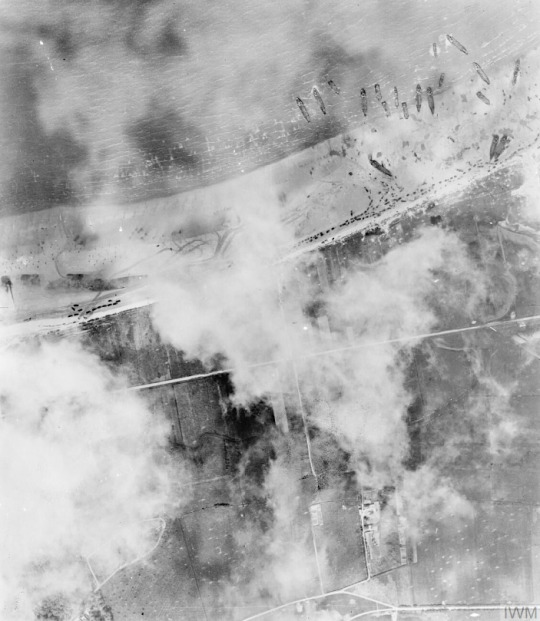
Packing Normandy
By the end of D-Day, 135,000 men had been landed and relatively few casualties were sustained – some 5,000 men. There were some serious cock-ups, notably the hopeless dispersal of the paratroopers (only 4% of the US 101st Air Division were dropped at the intended target zone), but, if anything, this caused even more confusion amongst the German commanders on the ground as it seemed the Allies were attacking everywhere. The defenders, overcoming the initial handicap that many area commanders were at a strategy conference in Rennes, did eventually organise themselves into a counterattack, deploying their reserves and pulling in troops from other parts of France. This is when French resistance and aerial bombing became crucial, seriously hampering the German army's effort to reinforce the coastal areas of Normandy. The German field commanders wanted to withdraw, regroup and attack in force, but, on 11 June, Hitler ordered there be no retreat.
All of the original invasion beaches were linked as the Allies pushed inland. To aid thousands more troops following up the initial attack, two artificial floating harbours were built. Code-named Mulberries, these were located off Omaha and Gold beaches and were built from 200 prefabricated units. A storm hit on 20 June, destroying the Mulberry Harbour off Omaha, but the one at Gold was still serviceable, allowing some 11,000 tons of material to be landed every 24 hours. The other problem for the Allies was how to supply thousands of vehicles with the fuel they needed. The short-term solution, code-named Tombola, was to have tanker ships pump fuel to storage tanks on shore, using buoyed pipelines. The longer-term solution was code-named Pluto (Pipeline Under the Ocean), a pipeline under the Channel to Cherbourg through which fuel could be pumped. Cherbourg was taken on 27 June and was used to ship in more troops and supplies, although the defenders had sunk ships to block the harbour and these took some six weeks to fully clear.
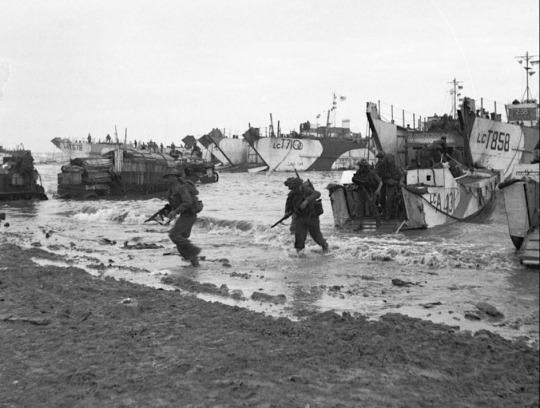
Operation Neptune officially ended on 30 June. Around 850,000 men, 148,800 vehicles, and 570,000 tons of stores and equipment had been landed since D-Day. The next phase of Overlord was to push the occupiers out of Normandy. The defenders were not only having logistical problems but also command issues as Hitler replaced Rundstedt with Field Marshal Günther von Kluge (1882-1944) and formally warned Rommel not to be defeatist.
Aftermath: The Normandy Campaign
By early July, the Allies, having not got further south than around 20 miles (32 km) from the coast, were behind schedule. Poor weather was limiting the role of aircraft in the advance. The German forces were using the countryside well to slow the Allied advance – countless small fields enclosed with trees and hedgerows which limited visibility and made tanks vulnerable to ambush. Caen was staunchly defended and required Allied bombers to obliterate the city on 7 July. The German troops withdrew but still held one-half of the city. The Allies lost around 500 tanks trying to take Caen, vital to any push further south. The advance to Avranches was equally tortuous, and 40,000 men were lost in two weeks of heavy fighting. By the end of July, the Allies had taken Caen, Avranches, and the vital bridge at Pontaubault. From 1 August, Patton and the US Third Army were punching south at the western side of the offensive, and the Brittany ports of St. Malo, Brest, and Lorient were taken.
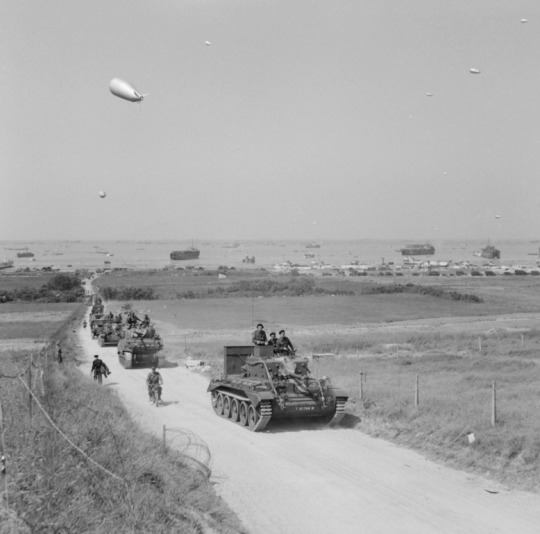
German forces counterattacked to try and retake Avranches, but Allied air power was decisive. Through August 1940, the Allies swept southwards to the Loire River from St. Nazaire to Orléans. On 15 August, a major landing took place on the southwest coast of France (French Riviera landings) and Marseille was captured on 28 August. In northern France, the Allies captured enough territory, ports, and airfields for a massive increase in material support. On 25 August, Paris was liberated. By mid-September, the Allied troops in the north and south of France had linked up and the campaign front expanded eastwards pushing on to the borders of Germany. There would be setbacks like Operation Market Garden of September and a brief fightback at the Battle of the Bulge in December 1944, but the direction of the war and ultimate Allied victory was now a question of not if but when.
138 notes
·
View notes
Text
for the love of GOD watch my jungle boy anime endinG *SOBBING ON MY KNEES*
this is the ed for my adult wrestling school au... jungle boy learns the power of friendship , love, HATE...and canadian destroyers! 🤼💕
110 notes
·
View notes